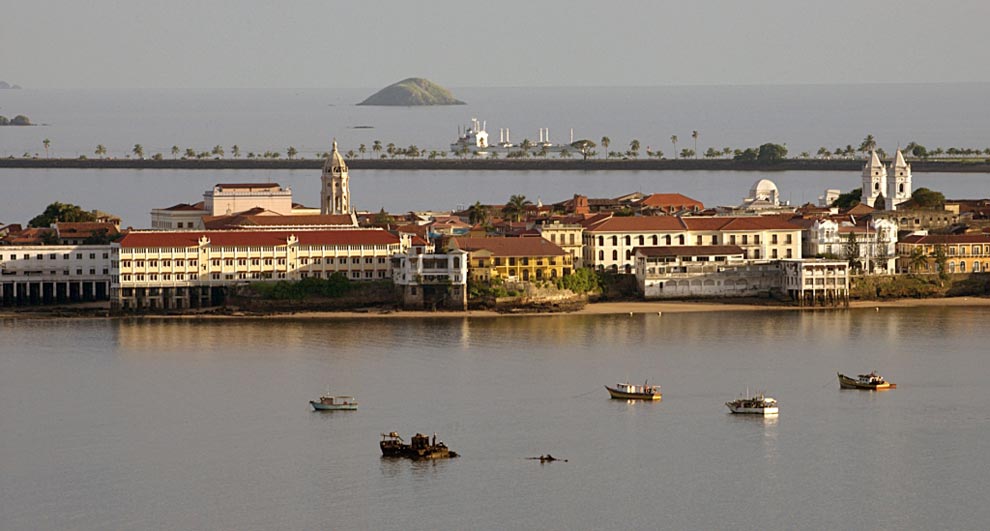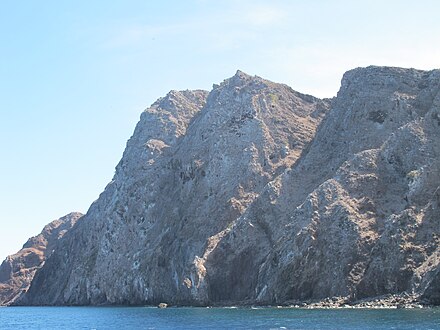This small island lies between the islands of
Nevis and
Montserrat, 56.2 kilometres (34.9 mi) southwest of
Antigua. Redonda is closer to Montserrat than to any other island; it is located at 22.5 kilometres (14.0 mi) northwest of Montserrat, and 32 kilometres (20 mi) southeast of Nevis.
Redonda is home to vast numbers of sea birds, and the island was an important source of guano before artificial fertilizers started to be mass-produced. Guano-mining operations started in the 1860s and ceased after the start of World War I. During these mining operations a few buildings and other installations were put in place on the island, and some physical remnants of that phase in its history are still visible.
The island of Redonda became part of Antigua and Barbuda in 1967.
Description
The west (leeward) coast of Redonda consists almost entirely of sheer cliffs many hundreds of feet high
A detail of the west coast shows the reddish volcanic rock cliffs and a small rock islet with a visible intertidal algal zone
At a distance, Redonda appears as if it were one very large rock. It is the remnant of an ancient extinct volcano. The land rises extremely steeply from sea level, mostly as sheer cliffs, especially on the leeward side of the island. At the top of the island there is an area of grassland that slopes quite steeply to the east. There is no source of fresh water other than rain.
Judging by the name he gave the island, to
Columbus the island appeared to be rounded, at least in profile. In reality the island is long and narrow, although it rises steeply to a height of almost 1,000 feet. The actual land area of the island is, however, hard to estimate because of the extreme steepness of the slopes, but it is calculated to be somewhere between 1.6 square kilometres (400 acres) and 2.6 square kilometres (640 acres).
Redonda is uninhabited, except by seabirds and a herd of feral goats that manage to survive on the poor grazing on top of the island. The steepness of the surface, the lack of a safe place to land a boat, and the lack of any fresh water source other than rainfall makes the island inhospitable to humans.
History
A small stone hut on the top of the island dates from the days when guano was mined there.
Christopher Columbus discovered Redonda in 1493 on his second journey. He claimed it for the
Spanish crown, but did not land there. He named the island
Santa María de la Redonda, meaning Saint Mary of the Round, reflecting the island's apparent profile when viewed from the side. In the 1860s, the island became a
British possession
[how?].
During the decades after the 1860s, the rich
guano (
phosphine oxide) deposits of Redonda were
mined for
fertiliser, with an annual yield of up to 7,000
tons. Only during this time was the island inhabited, by workers. The population was 120 in 1901. During the
First World War 1914, the mining operations ceased, and the workers left the island, which has remained uninhabited since then. Two stone huts still stand from the time when the island was occupied. Although the closest island to Redonda is
Montserrat, and the second closest is
Nevis, Redonda became a dependency of the more distant
Antigua, now part of
Antigua and Barbuda, in 1967.
Micronation
The island of Redonda as seen from
Nevis, with
Montserrat faintly visible in the distance
Redonda is internationally known, in a minor way, as a
micronation, because of the curious ongoing myth of the "
Kings of Redonda", a story which interweaves fact and fiction. According to a (possibly imaginary) version of events, first recounted decades later by
M.P. Shiel, an author of fantasy novels: in the year of his birth, 1865, his father
Matthew Dowdy Shiell, from
Montserrat, decided to celebrate his first male child by arranging for the boy to be crowned
King of Redonda at the age of 15, in a ceremony purportedly carried out on the small island by a bishop.
M.P. Shiel, the son and author, was the first person to ever mention the idea of the "Kingdom of Redonda" and that was in a promotional leaflet for his books. Since then, the title has been "passed down", and continues to the present day. For a period of time the "Royal" lineage of Redonda had a more or less solely literary theme, with the title being given to writers and the like, such as
John Gawsworth and
Jon Wynne-Tyson. Wynne-Tyson (King Juan II), his successor the Spanish novelist Javier Marias (King Xavier), and rival contenders for the Redondan title, such as Gawsworth, William L. Gates and Bob Williamson, were featured in a BBC Radio 4 documentary,
Redonda: The Island with Too Many Kings, which was broadcast in May 2007.
[5]
Wikimedia Commons has media related to Redonda.
Parishes and dependencies of Antigua and Barbuda









